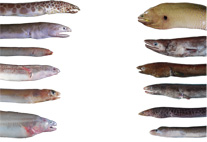Abstract
Three new species of false moray eels belonging to the genus Chlopsis, family Chlopsidae, are described and illustrated. Chlopsis sagmacollaris, from Western Australia, is characterized by its distinct color pattern with a unique dark saddle on the nape and paler body pigmentation than all other congeners. Chlopsis nanhaiensis, from Taiwan, has a bicolored body with its dorsal-fin origin behind a vertical through posterior margin of gill opening. These characters are shared with C. apterus, C. bicolor, C. bidentatus and C. orientalis sp. nov., but C. nanhaiensis has fewer total vertebrae than other bicolored species (ca. 120 in C. nanhaiensis vs. 125–140 in other four species). Chlopsis orientalis, from Vietnam, is distinguished from all other congeners except C. bicolor by its simple bicolored body, head length (ca. 10 % of total length), position of dorsal-fin origin (distinctly behind a vertical through posterior margin of gill opening), and counts of preanal and total vertebrae (35 and 135). Although C. orientalis resembles C. bicolor in meristics and morphometrics, it differs in its pigmentation and possession of stouter intermuscular bones. These new species represent the first records of the genus Chlopsis from the northwestern Pacific Ocean and the eastern Indian Ocean.

